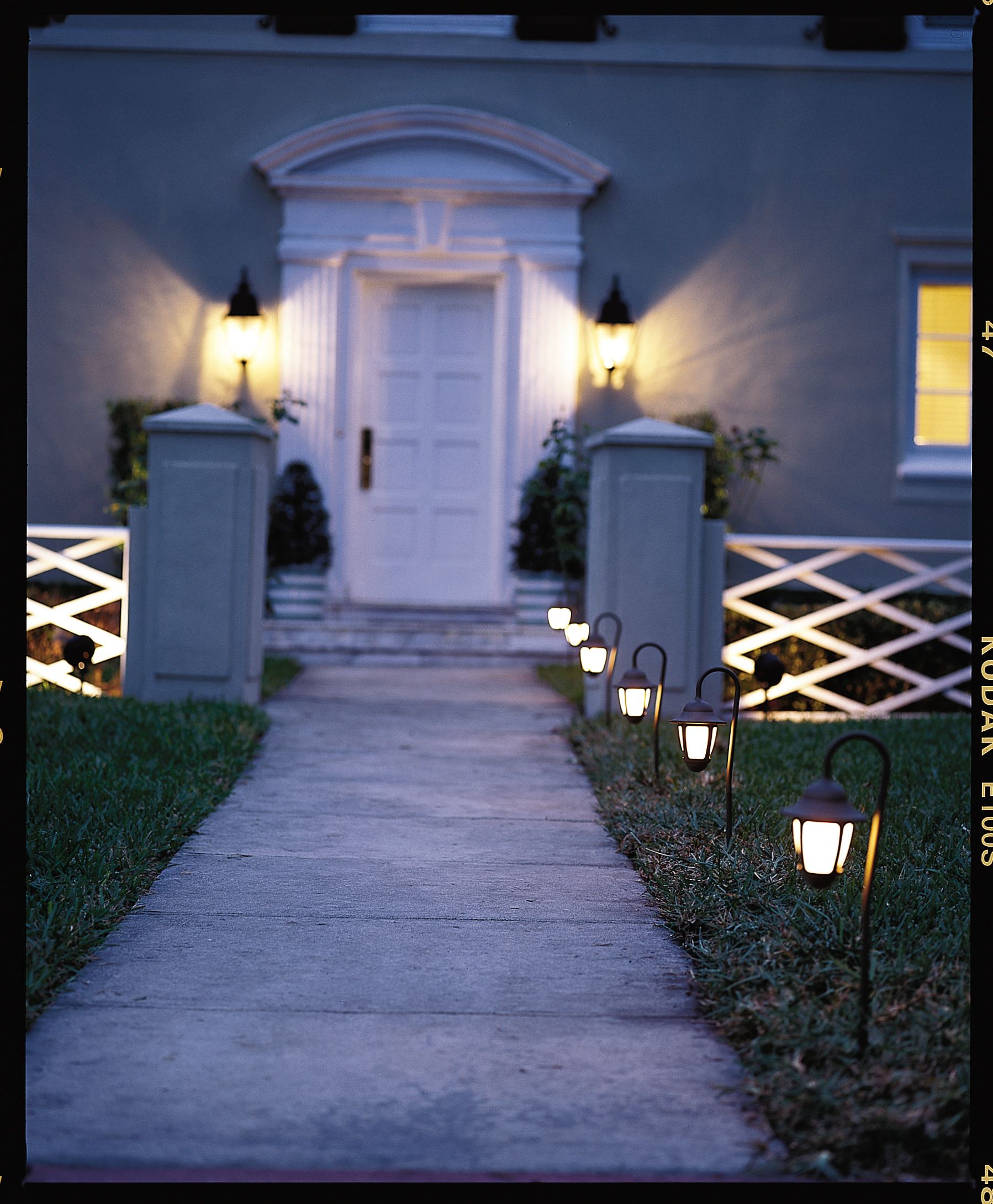We may be compensated if you purchase through links on our website. Our team is committed to delivering honest, objective, and independent reviews on home products and services.
Project details
Skill
Cost
Estimated Time
Landscape lighting can dramatically enhance your home’s nighttime curb appeal while improving safety and security. This DIY-friendly project involves installing low-voltage fixtures along walkways, driveways, and other prominent landscape features. This guide will walk you through the process of installing a landscape lighting system, from layout to final adjustments.
*Unless otherwise noted, costs in this article reflect an average of prices that our team found from hardware stores like Lowes and Home Depot, and on Amazon.com.
Landscape Lighting Overview
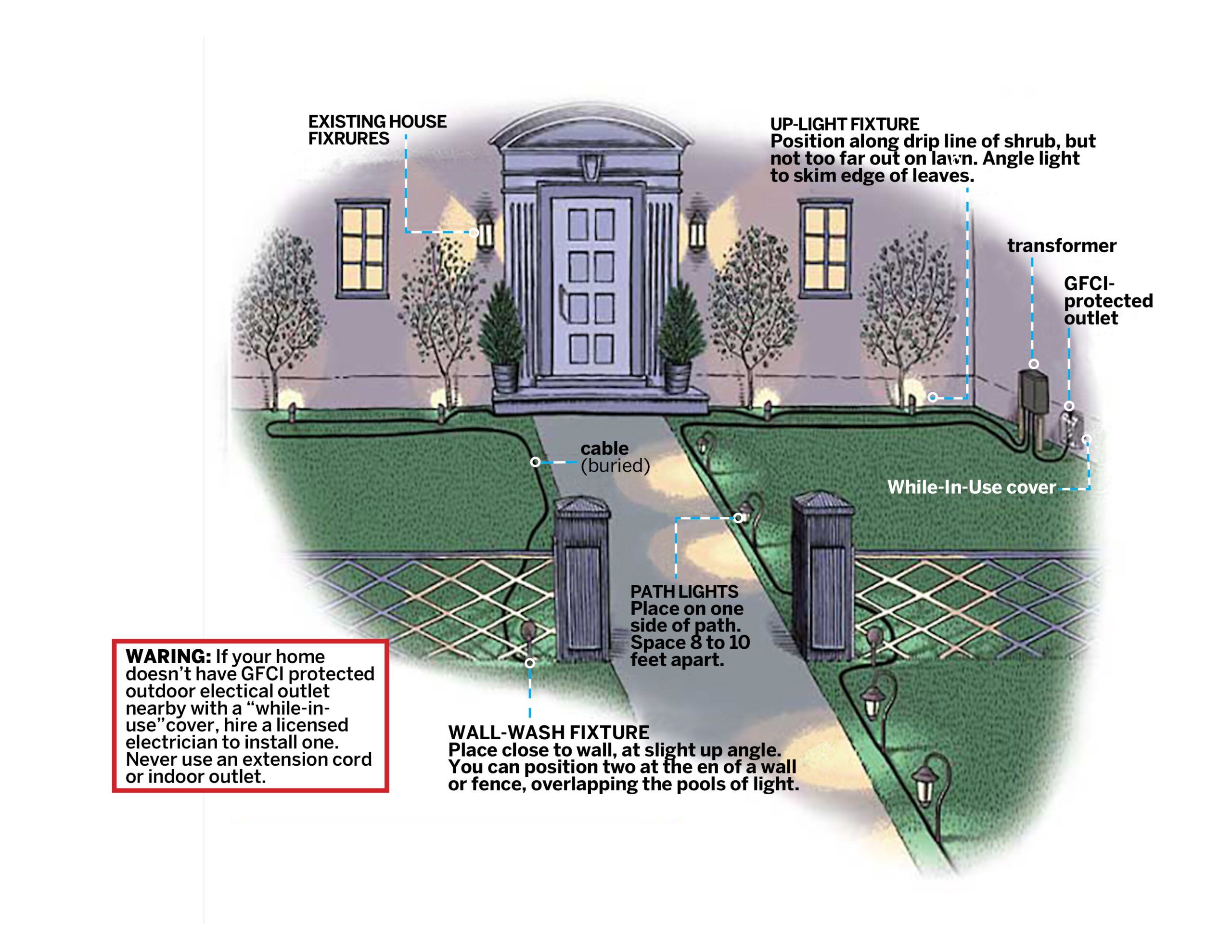
Shown above: A diagram of the basic parts of a landscape lighting system.
A low-voltage landscape lighting system typically consists of three main components—a transformer, low-voltage electrical cable, and light fixtures. The transformer reduces the standard 120-volt household current to a safer 12 volts, making it appropriate for DIY installation.
Designing Your Lighting Layout
When planning your landscape lighting system, consider the following:
- Choose fixtures that complement your home’s architectural style.
- Identify key areas to illuminate, such as walkways, steps, and focal points.
- Calculate the total wattage of your fixtures to select an appropriately sized transformer.
- Determine the best location for your transformer.
The transformer must be plugged into a ground fault circuit interrupter (GFCI) outdoor electrical outlet fitted with a “while-in-use” cover and an oversized plastic box that closes over the power cord. The transformer needs to have enough capacity to support the cumulative wattage of the lights in the system. Between fixtures, the cable is buried in a shallow trench. As long as you have a nearby outlet, you’ll be able to give your home and yard a welcoming glow when the sun goes down.
What We Chose
At the stately 1930s-something home shown in the diagram, we installed 12 Intermatic fixtures in three different areas. Alongside the walkway leading to the entry are six decorative aluminum fixtures that have a curved shepherd’s hook profile.
Two 20-watt wall-wash fixtures are used to illuminate the white-painted lattice fence on either side of the walkway. At the base of each of the four evergreen shrubs growing against the house is a 20-watt shrub uplight. The 12 fixtures are connected with a 12-gauge cable and powered by a 300-watt transformer.
Tools and Materials
In addition to the lighting fixtures and low-voltage cables themselves, you’ll need the following tools to install a landscape lighting system:
- Flat-blade shovel
- Safety glasses
- Small sledge hammer (if necessary)
- Steel punch (12-inch) or large screwdriver
- Tape measure
- Wire stripper
- Work gloves
Step 1: Lay out the Lighting Components
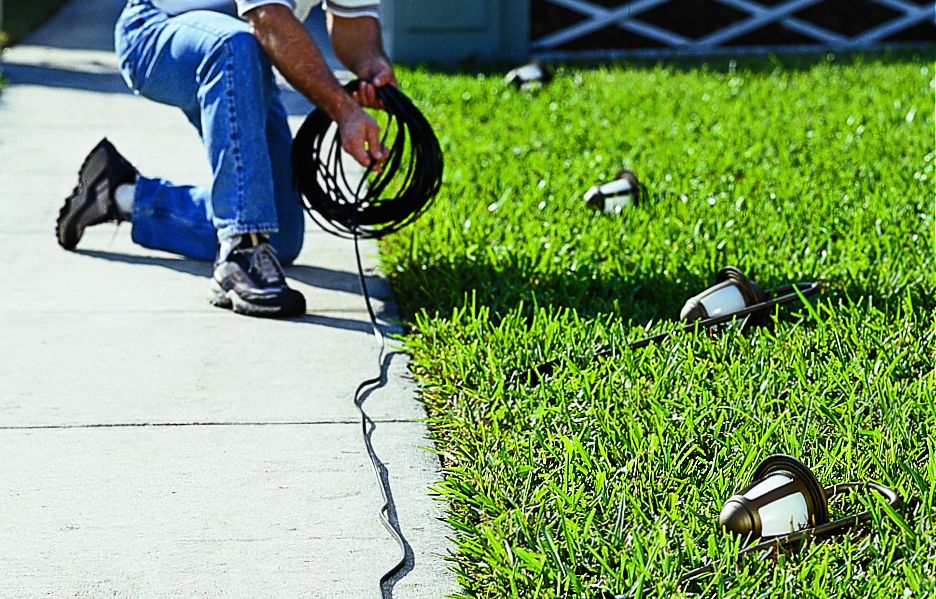
Before you begin installation, lay out the components of the system to ensure you have long enough cables.
- Place the first fixture at least 10 feet from the transformer to ensure even light distribution.
- Position the pathway light fixtures on the ground where you intend to install them, typically 8 to 10 feet apart.
- For safety reasons, don’t place any fixtures within 10 feet of pools, spas fountains, or other water features.
- Lay the low-voltage cable along the concrete walkway, following the line of light fixtures.
- When encountering obstacles like fences or shrubs, plan to route the cable under or around them.
Pro tip: Use 14-gauge cable for lighting systems totaling 200 watts or less, and 12-gauge cable for systems exceeding 200 watts.
Step 2: Turn over the Sod to Lay the Cable
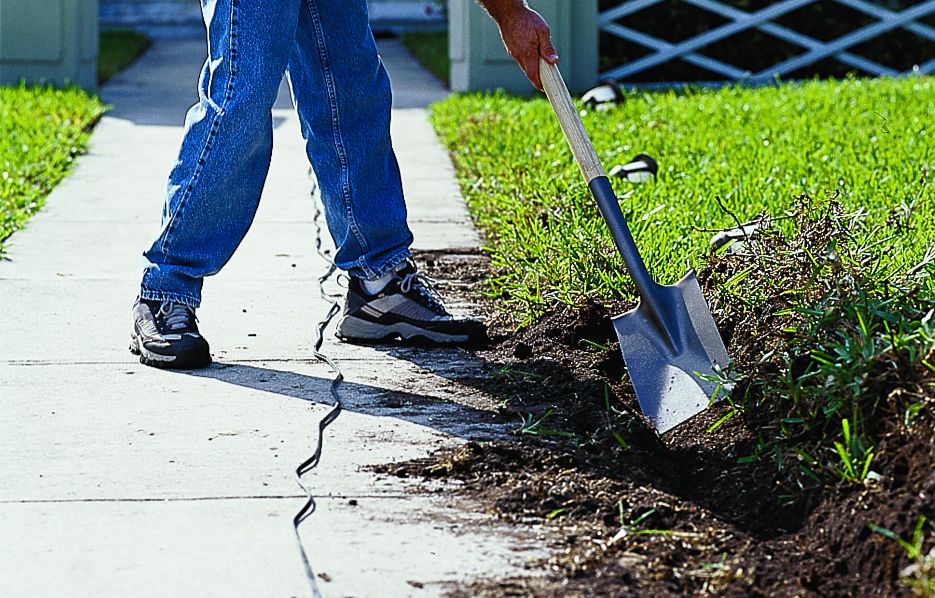
If your turfgrass is grown from seed, you’ll likely need to dig directly into the ground and reseed afterward. However, if your yard has sod like our project house did, the following method allows for easy cable installation and minimal disruption to your lawn.
- Temporarily move the light fixtures out of the way to access the installation area.
- Use a flat-blade shovel to slide underneath the top layer of grass, approximately 12 inches from the edge of the walkway.
- Lift the shovel handle to separate the grass from the soil, creating a flap of sod.
- Continue this process along the entire length of the walkway where you plan to install the lighting.
- Use the corner of the shovel’s blade to create a 3-inch-deep trench in the exposed soil for the wire.
Pro tip: If necessary, place the light fixtures on top of the folded sod to prevent it from falling back into place while you work.
Step 3: Bury the Electrical Cable
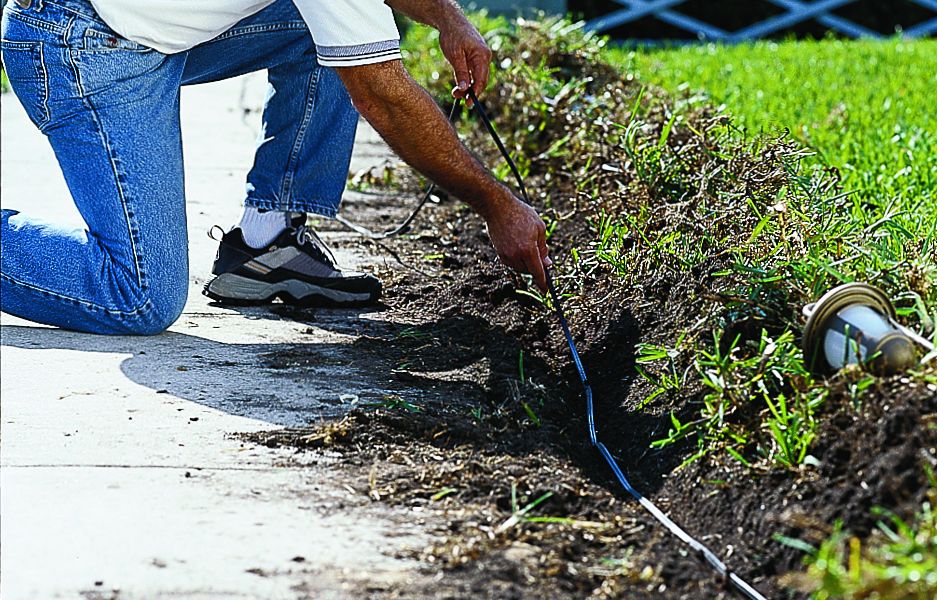
With the trench prepared, it’s time to install the low-voltage electrical cable. If you don’t have sod, you can skip the steps that reference it.
- Carefully lay the low-voltage electrical cable in the prepared trench.
- Leave a small amount of slack at each fixture location to allow for easy connections.
- Gently cover the cable with soil, but leave it exposed near each fixture location.
- Make a small slit in the detached sod where each fixture will be placed.
- Fold the sod back over the soil, ensuring the cable for each fixture remains above the grass.
Pro tip: Remember not to bury the cable deeper than 3 inches or you’ll have difficulty connecting the light fixture later.
Step 4: Plug in the Transformer for the Lighting System
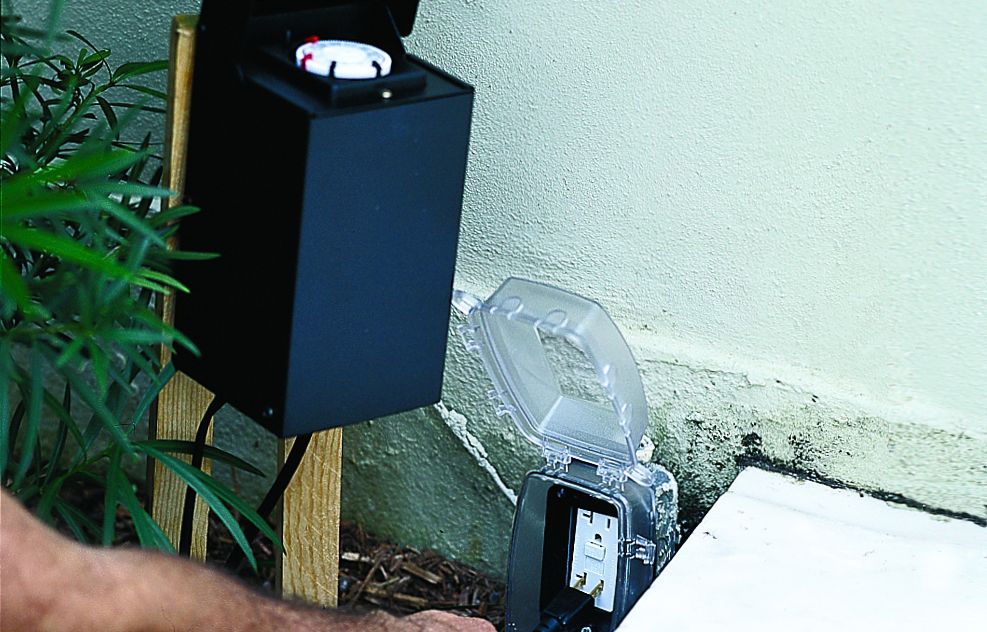
Connecting the transformer properly makes for a safe and efficient lighting system, so take care with these steps.
- Run the main cable up to the outdoor electrical outlet where you’ll install the transformer.
- Use wire strippers to cut the cable and remove ½ inch of rubber insulation from the ends.
- Insert the stripped wires under the two terminal screws on the bottom of the transformer, then tighten the screws securely.
- Drive a wooden stake into the ground next to the outlet, or prepare to mount the transformer directly on an exterior wall.
- Attach the transformer to the stake or wall using appropriate screws and hardware.
- Lift the “while-in-use” cover on the GFCI-protected outlet and plug in the transformer.
Pro tip: Ensure that the transformer is properly sized for your lighting system’s total wattage.
Step 5: Prepare Holes for the Lighting Fixtures
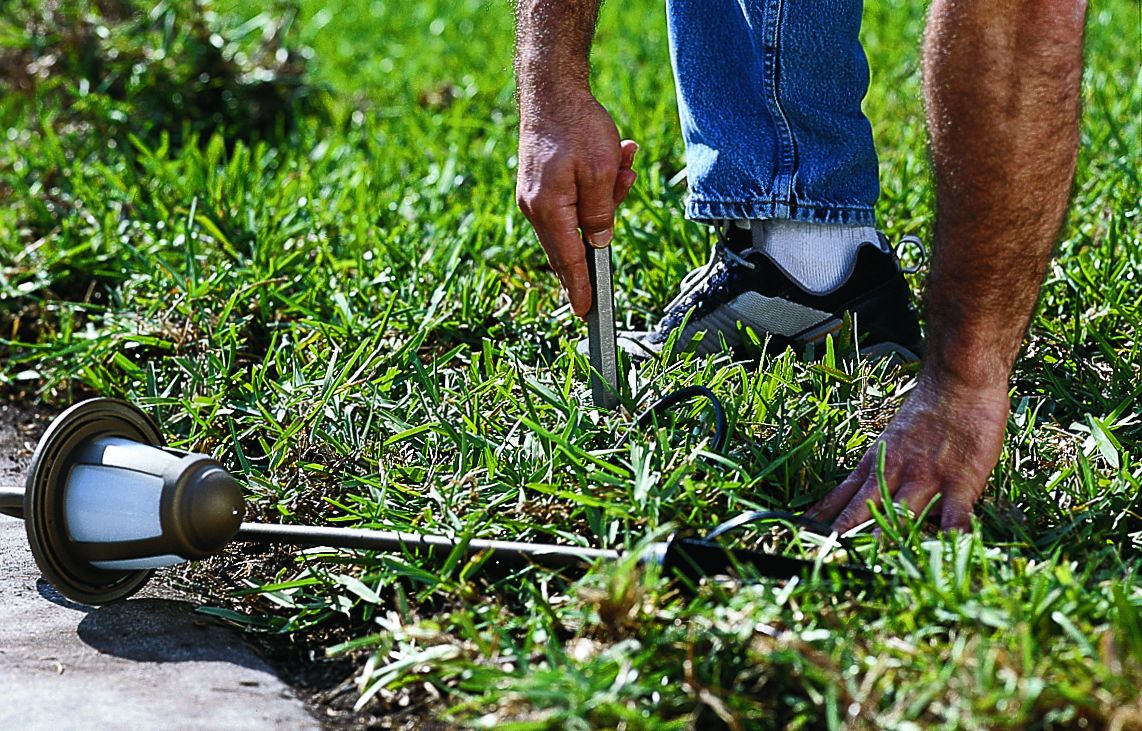
Next you’ll need to prepare the ground for each light fixture.
- Reposition all light fixtures in their designated locations, confirming equal spacing between them.
- Place the first fixture as close to the walkway edge as possible without any part extending over it to prevent tripping hazards.
- Use a large screwdriver or long steel punch to create a hole in the ground for each fixture’s stake.
Pro tip: If necessary, use a small sledge hammer to drive the screwdriver or punch. However, avoid using a hammer to drive fixtures directly into the ground, as this can damage their components.
Step 6: Make the Electrical Connections
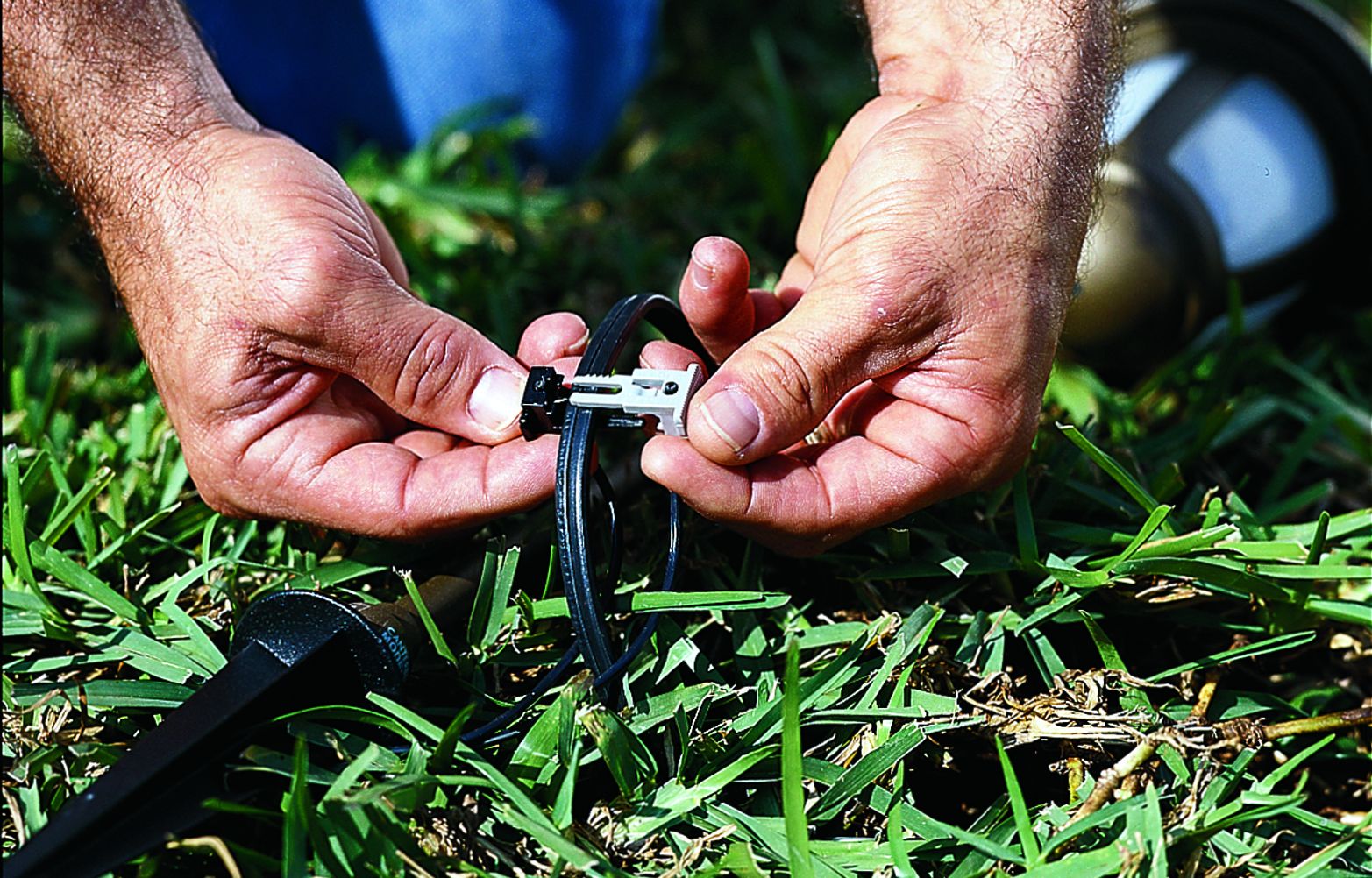
Connecting the fixtures to the main cable is a straightforward process. The sharp prongs inside the connectors will pierce the cable insulation, making contact with the internal wires.
- Locate the two connector halves attached to the bottom of each light fixture.
- Position these connectors over the exposed section of the main cable protruding from the sod.
- Firmly press the connector halves together until you hear a distinct click, indicating a secure connection.
- With the transformer plugged in, the fixture should illuminate, confirming a successful connection.
Pro tip: If a fixture doesn’t light up, try disconnecting and reconnecting the connector. If issues persist, check the bulb or consult the manufacturer’s troubleshooting guide. If none of the fixtures light up, you may have a faulty transformer or outdoor electrical outlet that requires professional inspection.
Step 7: Install the Light Fixtures

With the electrical connections made, it’s time to install the light fixtures permanently.
- Insert each light fixture into its corresponding metal ground stake.
- Using both hands, carefully push the fixture and stake into the prepared hole until the top of the stake is flush with the ground.
- Visually inspect each fixture to ensure it’s not tilted to one side, adjusting as necessary.
- Gently tuck the cable and connector under the sod, burying them about 2 inches deep in the soil.
- Repeat this process for all remaining fixtures in your lighting system.
Pro tip: Take care not to force the fixtures into the ground, as this could damage the components or disturb the electrical connections. If you need more than gentle, steady pressure, remove the stake and use your screwdriver or punch to enlarge the hole.
Step 8: Replace the Sod
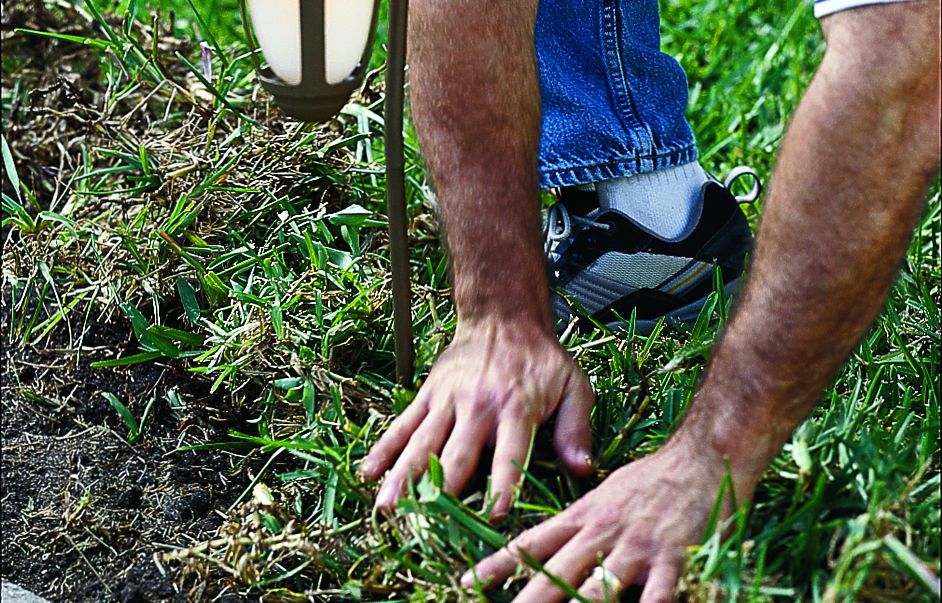
The final step in your landscape lighting installation is to restore the lawn to its original condition. Here’s how that works for sod.
- Once all light fixtures are installed and functioning correctly, carefully smooth out the sod around each fixture using the slits you cut earlier.
- If necessary, use the shovel to trim any excess sod around the light fixtures for a neat appearance.
- Firmly press down on the replaced sod to ensure good contact with the soil beneath.
- Use a garden hose to thoroughly water the area, promoting quick reestablishment of the grass.
- Monitor the sod over the next few weeks, providing additional water as needed to help it recover fully.
Pro tip: When using your new lighting system, promptly replace a burned-out bulb or it will shorten the life of the other bulbs.
Tools
 Flat-blade shovel
Flat-blade shovel Wire stripper
Wire stripper Phillips screwdriver
Phillips screwdriver 12-inch-long steel punch
12-inch-long steel punch Small sledgehammer
Small sledgehammer
